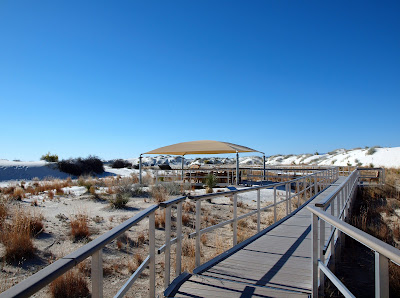By 8:30am we were driving into the gate to the White Sands. The weather was even cooler than yesterday but the sun was coming up and soon it would be warm.
View on the way to WS
The White Sands is actually part of the Chihuahuan Desert. As I said before part of the Tularosa Basin was a huge lake called Lake Otero. Millions of years ago gypsum crystals were formed from the winds and rains. Over time these crystals wore down into what we now call the white sands. The once large Lake Otero is now know as Lake Lucero and Lake Lucero is very very small in size. It has no water on the surface unless a rain storm adds a bit but those large crystals are in abundance, just waiting to wear down into gypsum sand. You have to keep in mind that this was millions of years in the making. So you see the white white sand is not really sand as we know it. It's Gypsum!!
The White Sand has become one of the worlds greatest natural wonders - The glistening white sands are great wave-like dunes of gypsum sand and have engulfed over 275 square miles of desert land. It has become one of the largest gypsum dunes fields in the world. The dunes are ever changing, they grow, they crest, then slump down ever advancing east. The southwest winds drive the sand and it covers everything in it's path. I mean everything! A favorite saying about the plant life is: Live fast and die young. This is due to the fact that they just get started in their growth pattern and then the ever moving gypsum pushes it's way to and over these plants. Only a very few can survive this battle. One is perhaps the Cottonwood tree which is able to grow fast and put down deep roots and is able to 'keep it's head above the sand.'
White Sands Park Visitors Center
The park has walking trails. They encourage you to follow the trail as the white dunes tend to look much alike. They have posts showing the way and they are often and painted orange. The Playa Trail is a short walk and not difficult at all.
Playa Trail View
The Dune Life Nature Trail is a loop trail and is about a mile in distance. This has a couple of steep hills to climb but not difficult either.
This would be Jim and I
Pedestals
Sand collects around a tree and it becomes a haven for the small animals that live in the White Sands.
Barren Tree
The Interdune Boardwalk is deck material and easy and short.
The ripple effect is from the wind blowing from the west to the east. This is the top side and the sand is packed hard. You hardly leave foot prints it's so hard.
Looks just like snow
Remember that saying - Live fast die young
These plants are about to be covered with sand.
Only a very few plants survive.
Road in and around park.
Because of the ever moving gypsum sand they can not pave the road as it is a constant struggle to keep it open because of the moving sand. When a dune is up close to the road they will start a new road behind the dune. The road looks icy but it's just the sand. They had a really bad rain storm and a lot of the sand was still wet.
The most difficult trail is The Alkali Flat Trail and this one is about 4.3 miles. We only walked a short distance and turned around and came back. The night before we did the Sunset Trail walk and that also was easy.
This is from sand falling down on the south east side of the dune. The sand up to the top before it spills over the east side is very hard packed but on the downward side it is fluffy white sand. You sink in easily. The dune move about fifteen feet a year.
Jim showing you how fine the sand is.
Here a whole section of the east side slides down the dune. It's very soft on the top surface.
















No comments:
Post a Comment